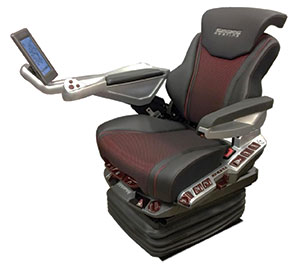Special to Transport Topics
Skin, Musculoskeletal Health Essential for Truck Drivers

[Stay on top of transportation news: Get TTNews in your inbox.]
When truck driver health care comes to mind, most think of cardiovascular or weight issues. However, skin care and musculoskeletal well-being are also growing concerns.
As for skin care, the amount of exposure to sunlight and ultraviolet (UV) rays is a prominent factor in proper health maintenance. Although a casual amount of sun exposure provides healthy doses of Vitamin D, too much exposure causes skin damage and could lead to skin cancer. To protect over-the-road drivers, the front windshield is built to shield against the most dangerous UV rays; however, there is no equivalent protection on the driver-side window.
At his practice, Dr. Scott Fosko, a Jacksonville, Fla.-based dermatologist, noticed that many of his patients with skin cancer have asymmetric damage to the left side of their heads and necks.
Over time, a driver who spends a lot of time behind a wheel could be at an increased risk for skin cancer.
Dr. Scott Fosko
Through collaborative research, he and a colleague published data in the Journal of the American Academy of Dermatology, finding that facial cancers were more prevalent on the left side of the face, consistent with where Americans sit to drive. Specifically, 74% had lentiginous melanoma — a variant found on sun-damaged skin of limbs — on the left side, which supported cumulative exposure over time.
Fosko explained, as the least dangerous UV ray, UVB rays cause sunburns at overexposure, but UVA rays penetrate more deeply and contribute to photoaging.
“This is relevant because glass tends to filter ultraviolet B but does not filter ultraviolet A,” he said. “Over time, a driver who spends a lot of time behind a wheel could be at an increased risk for skin cancer.”
Fosko added that melanoma is known as the deadliest form of skin cancer, although it is very curable if caught early. Other forms of common skin cancer, basal cell carcinoma and squamous cell, often progress and also are curable if diagnosed early. Those with fairer complexions are most at risk.
“Squamous cell is slow growing but can be more aggressive and a little higher risk of becoming metastatic,” he explained, recommending skin protection through self-exams and annual dermatology visits.

For drivers, the most common musculoskeletal issues are lower back pain. In some cases, the cause is from improper use of the seat’s lumbar support. (gilaxia via Getty Images)
For drivers, especially this summer season, sun overexposure is a constant when driving long hours at a time. Fosko contends that the first step is to become aware of the risks.
“We tend to think of needing to protect skin at the beach, but be aware that the risk is real, and the exposure is real,” he said. “Over time, the exposure does add up; for a professional driver, it is magnified.”
Fosko suggested drivers, particularly those with fair complexions, wear a broad-spectrum sunscreen that protects against both UVA and UVB rays, and wear protective clothing, as well as a wide-brim hat. In addition, they should not ignore changes or suspicious areas that appear on their skin.
Drivers also can use tinted window films known for filtering out the most harmful of the sun’s rays that can go right through window glass, even on a cloudy day.
“The windshield is not a big deal because it has laminated glass that effectively blocks the damaging rays, but the UV rays are a particular concern in the side windows, or if someone has the truck windows rolled down,” said Randy Garcia, a technical specialist with Avery Dennison, headquartered in Mentor, Ohio.
“UVB is blocked by glass; UVA comes through glass, and our films block those UVA rays,” he said. He added that not only can the window tinting products reduce the UV damage that can occur, it can do a significant job of reducing excessive heat coming through the glass. The products can be retrofitted on existing glass at an aftermarket shop.
Garcia also noted that each state has its own window tinting laws that allow for a specific percentage of visible light allowed through a vehicle’s windows.
Neck and Back Pain
As driving is a sedentary activity without much opportunity for change of position, truck drivers are prone to aches and pains as a result.

Dixon
The most common complaint from a musculoskeletal standpoint is lower back pain. “A lot of drivers aren’t using the lumbar support properly in their trucks. This is one of the most physically demanding things you can do: Driving down the road, with constant vibration on the disk causes a lot of low back pain, and if you’re not sitting with proper posture, being in a bad position all day long can cause pinched nerves, pulled muscles, aches and sciatica,” said Dr. Bethany Dixon, owner of Drivers Health Clinic, with two locations inside truck stops in Florida.
Dixon said she also sees a lot of repetitive motion issues in shoulders and necks. Poor posture can also lead to neck pain and headaches, while improper lifting can cause injury as well. Even hitting one pothole can jar the back and cause problems. Long-term, these issues can be problematic.
“If you don’t start fixing the small problems, they definitely can transition into a large problem,” she noted, adding that, for example, a low back issue can turn into disc issues, arthritis and chronic daily pain.
Akin to a pre-trip truck inspection, Dixon created a personal pre-trip for truckers, a seven- to 11-minute routine that drivers should undergo before a long drive. “Stretching is key; you are less prone to injury if you stretch. If you have good posture while you’re driving, you’re much less likely to have chronic injuries,” she said.
Armrests are very important, Dixon added, and they should be positioned so that they are at a comfortable distance so that a driver is not putting constant repetitive pressure on necks and shoulders.
“If you don’t have proper lumbar support, the back of the disc is being pushed in a direction it shouldn’t,” she explained. “Chronically pushing on a nerve can cause it to become pinched/impinged, and then chronically, you end up with pain going down to the leg and the feet.”
Proper Seating
Making sure the seat fits correctly is a major key in preventing back and neck injuries.

Some trucks are outfitted with an ergonomically designed seat with an optimized suspension and a high degree of adjustability. (Sears Seating)
Some trucks are outfitted with an ergonomically designed seat with an optimized suspension and a high degree of adjustability. Sears Seating, a manufacturer headquartered in Iowa, has developed a seat with features that can adjust for the operator. These adjustable features include “seat height, seat tilt, cushion adjustment for the legs and back, bolsters to hug the operator, and different mechanisms to decrease and increase lumbar support,” said Jeff Linnberg, Sears Seating’s advanced engineering manager.
Also, having a seat with optimized suspension mitigates the effects of certain harmful vibrations.
“Not only does the seat have to keep the driver safe for many hours but also that split second that they go over a bump or a hit a log,” said Wayne Ward, Sears Seating’s vice president of engineering.
Still, despite all the engineering and research that goes into a driving seat, it is not without its challenges. Designing a product for the different body makeups of all truck drivers can be challenging, from taller, heavier men, to smaller, thinner women. Another challenge, added Ward, is that customers cannot describe what is comfortable, but they can describe what is uncomfortable.
Want more news? Listen to today's daily briefing above or go here for more info
There are also driver rehabilitation specialists who can help a truck driver do a comprehensive driving evaluation, testing clinical abilities and performance on the road, says Elin Schold Davis, Coordinator Older Driver Initiative with the American Occupational Therapy Association. Depending on the issue, this specialist can point a driver in the right direction to the proper specialist or occupational therapist and do ergonomic consultations — helping to evaluate whether any physical equipment in a vehicle needs to be modified or prescribing a different seating system.
Dixon added that overall health is also a big factor in preventing pain. For example, being significantly overweight could make a driver more prone to inflammatory issues, so good, healthy eating is important too. The more inflammatory foods you eat (think white sugar and refined white four), the more pain you will have. “You can’t have a million-dollar body on a 99-cent menu, so pay attention to what you are eating,” said Dixon.
It is counterintuitive to a prevention approach to keep doing something until it causes pain. “The best time to start habits is in the very beginning, because it’s hard to break a bad habit,” she said. “Invest in yourself. You only have one body; you’re not going to get a replacement.”


